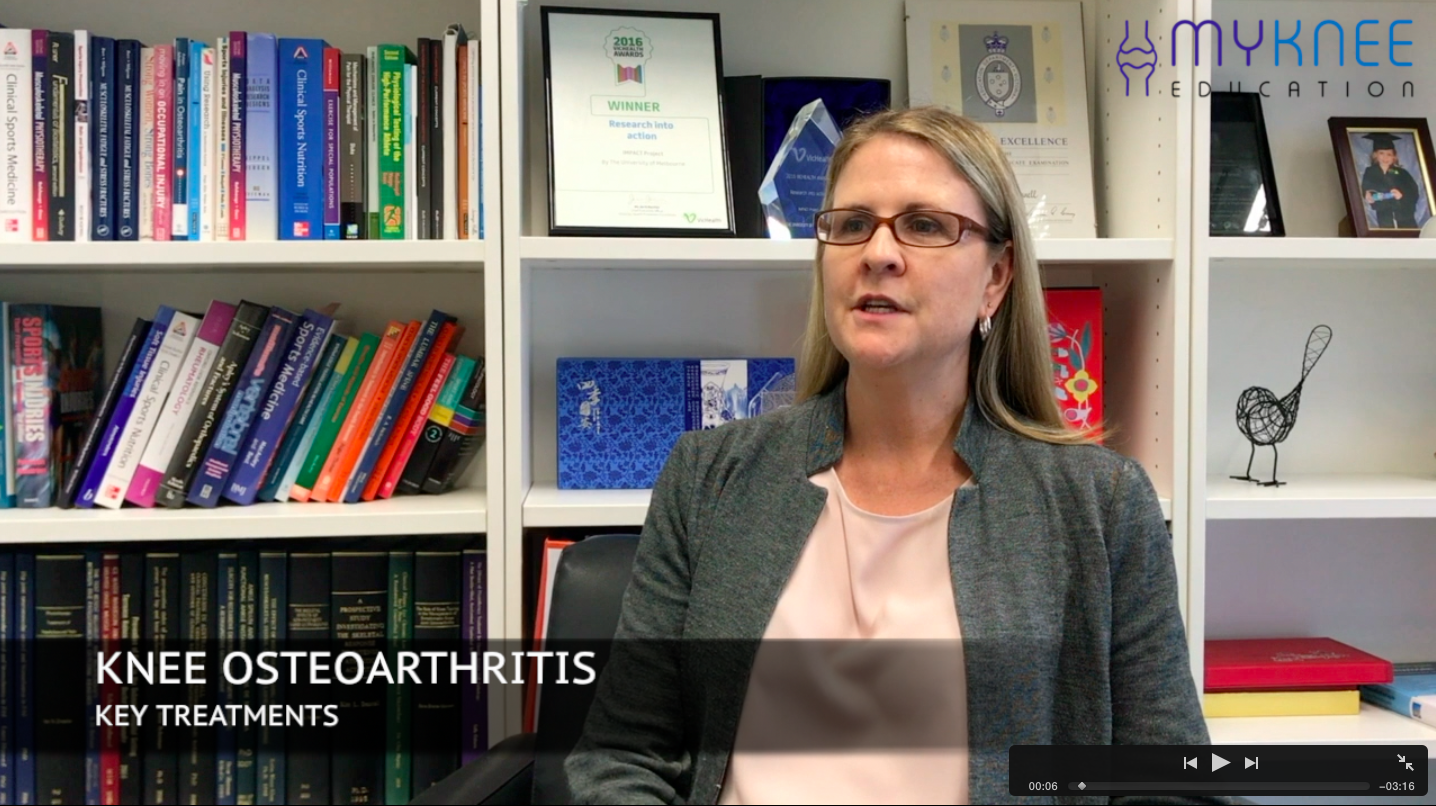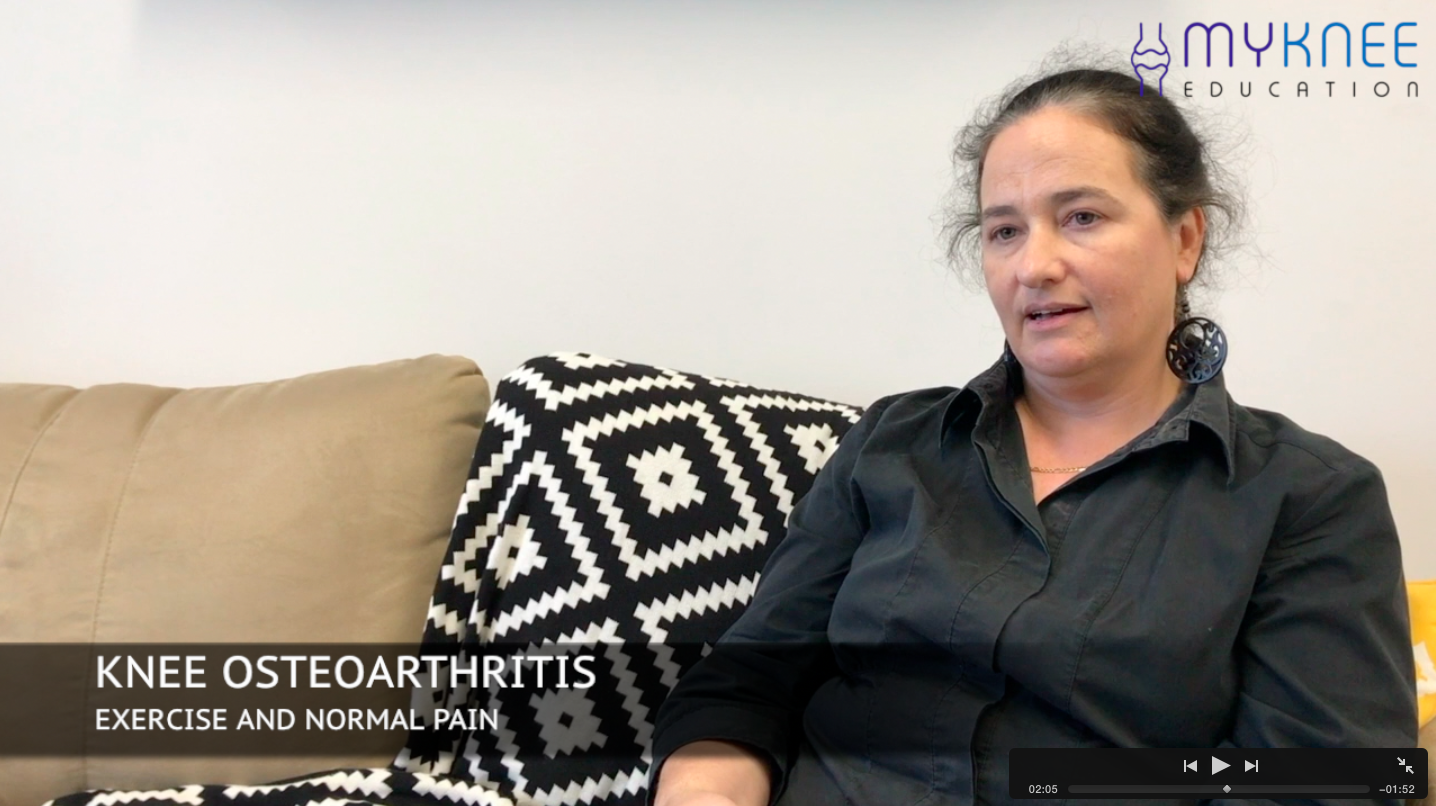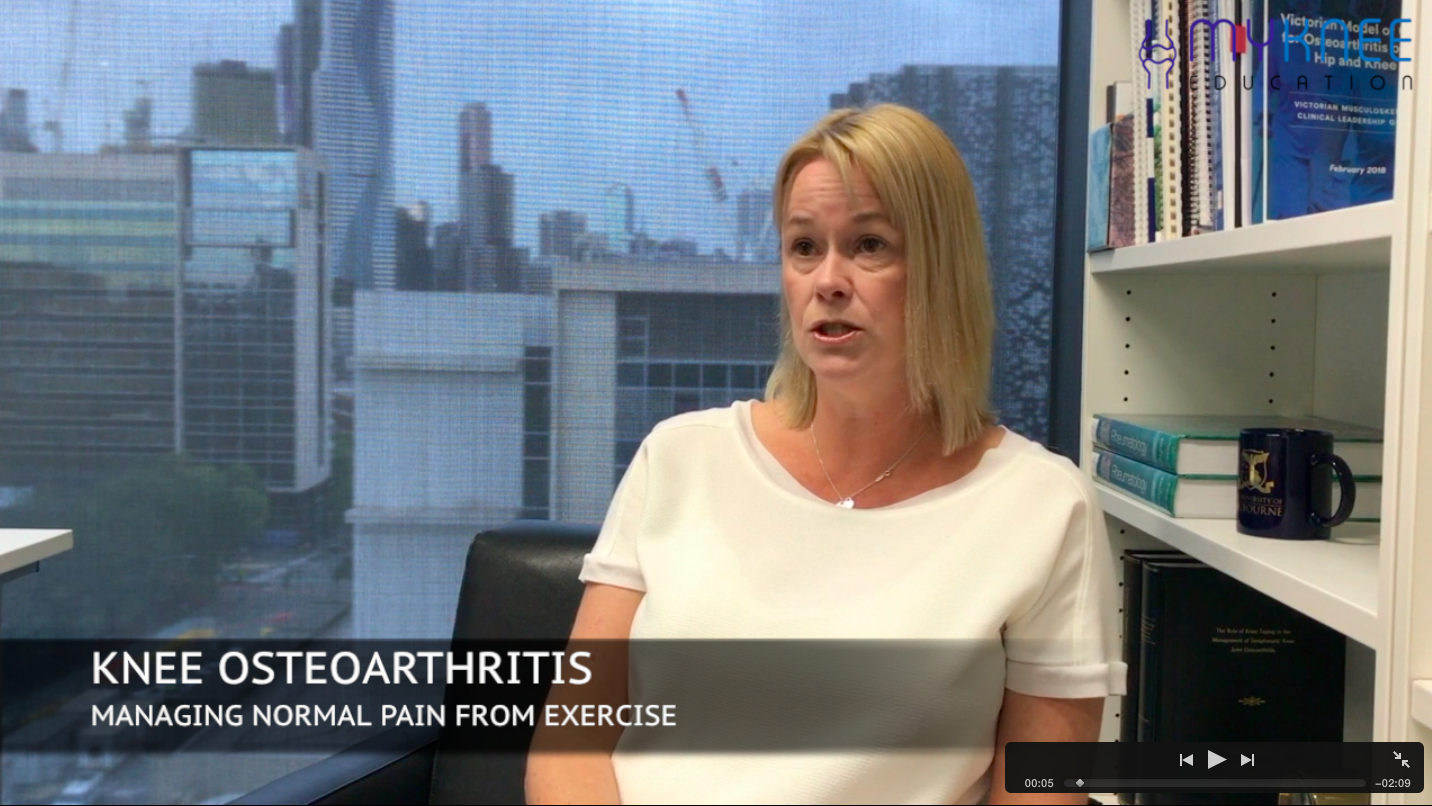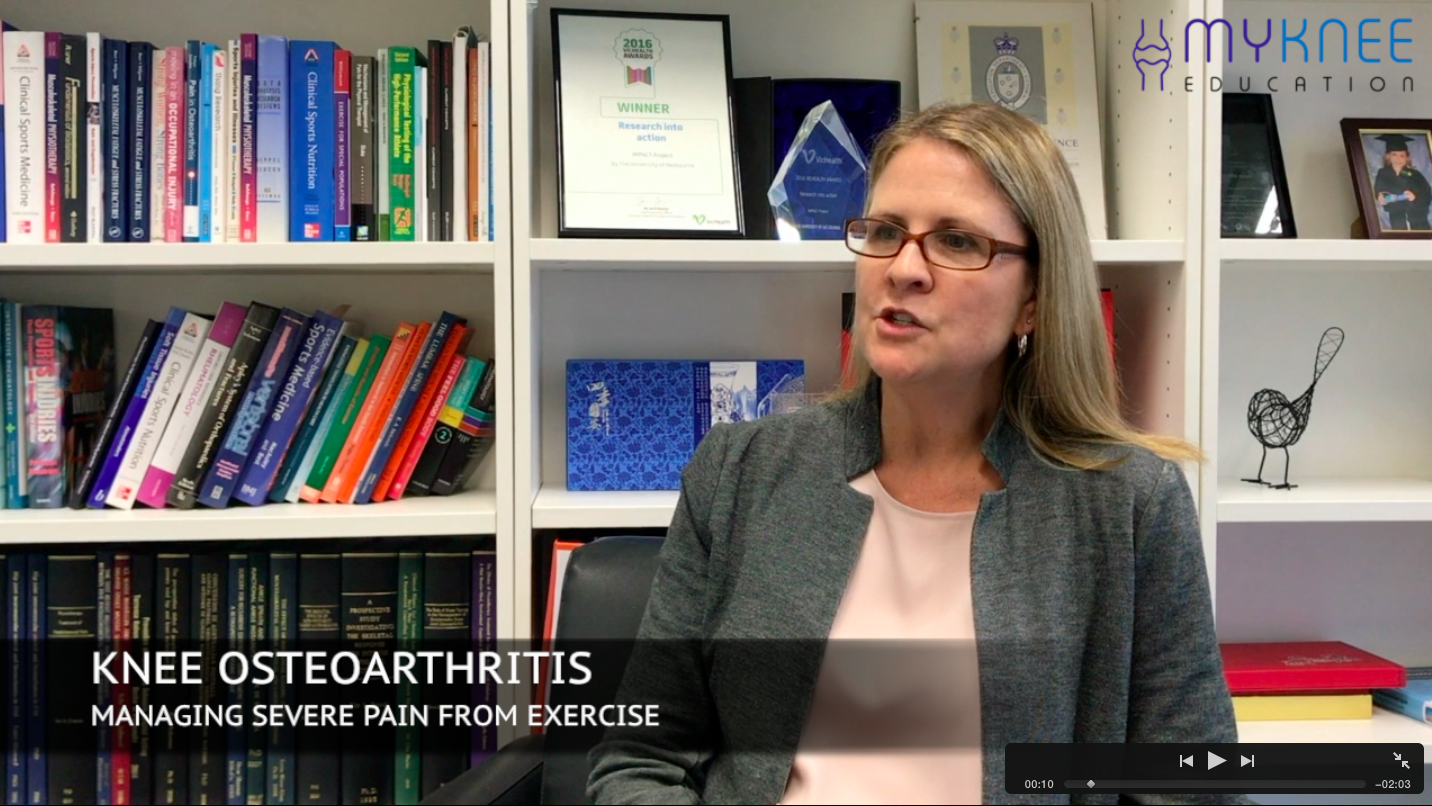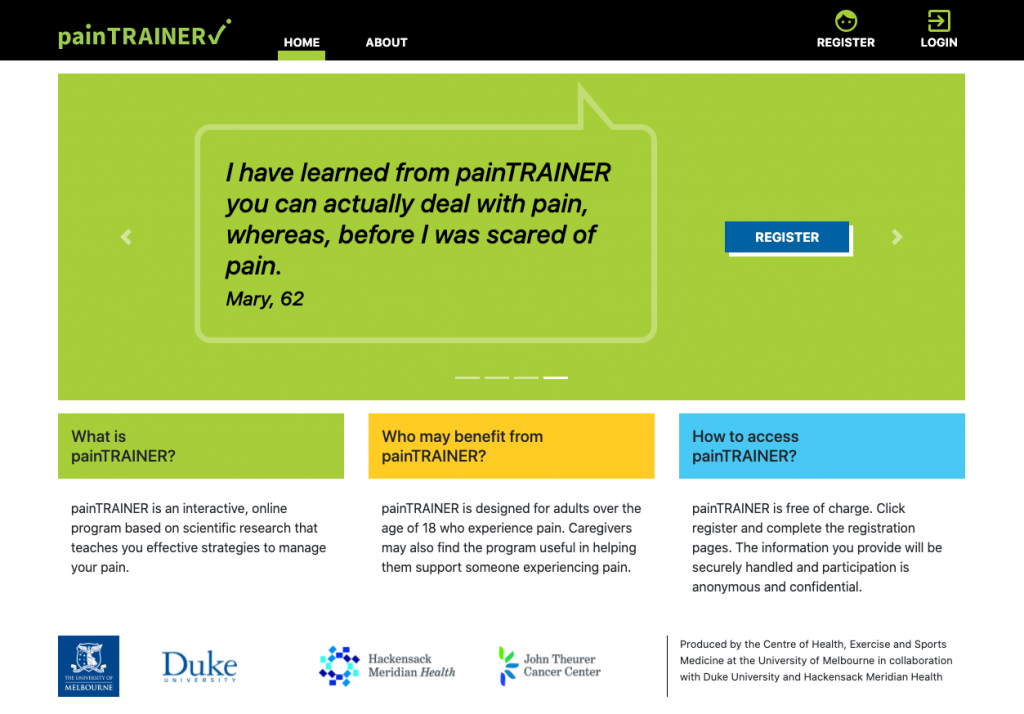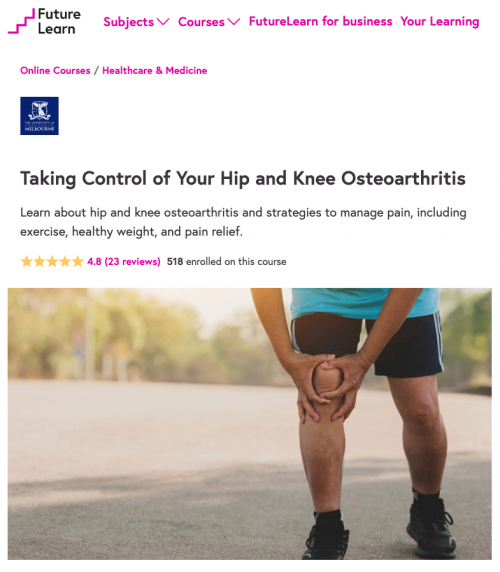My Knee Education
It’s time to change the way we think about knee pain and exercise.
There is a lot of incorrect information around about knee pain, osteoarthritis and exercise.
Mostly, this information is old fashioned or out of date.
Read each section to learn more about exercise and knee pain. You’ll then be ready to start your My Knee Strength program.
Scientific research has helped us understand knee osteoarthritis better.
Persistent knee pain, in people over 45 years old, is often called knee osteoarthritis.
Knee osteoarthritis affects the whole joint. There can be changes in the cartilage, bone, ligaments and muscles of your knee. Normal day to day activities can feel harder than they used to. Knee pain and stiffness is common.
A lot of information about knee osteoarthritis is incorrect. Incorrect information is mostly old fashioned or out of date. We once thought knee osteoarthritis pain was ‘wear and tear’ of the knee joint leaving ‘bone on bone’. New research has helped us understand knee osteoarthritis better. We now know this isn’t true. In fact, we think the complete opposite is true. Knee osteoarthritis pain is most likely caused by a joint working extra hard to repair itself.
Here are some reasons we no longer think knee osteoarthritis pain is ‘wear and tear’ or ‘bone on bone’.
Knee x-ray images are not an indication of knee symptoms.
Often a person’s knee x-ray image does not match their symptoms. People can have a lot of joint changes on x-ray but minimal or no pain. Others can have bad pain but the x-ray image doesn’t show changes that explain the pain. We now know the knee’s condition on x-ray does NOT equal the pain felt in the knee. This is why x-rays are no longer recommended to diagnose or manage painful knee osteoarthritis.
Pain can change daily. The condition of bone and cartilage does not.
An x-ray taken today will look the same as yesterday’s x-ray, and last week’s x-ray. In contrast, people with knee osteoarthritis know pain changes day to day or even hour to hour. Again, this shows us that there is a mismatch between pain and the joint’s condition.
Not everyone gets worse.
In fact, only about a third of people get worse over time. Most people remain stable. They have bad patches and good patches but don’t continue to worsen. Some people even get better over time. Avoiding exercise, like walking, to prevent the knees from ‘wearing out’ isn’t correct. Walking and other exercise is actually a good way to reduce pain over time and keep the knees healthy.
Symptoms improve with movement.
You may have noticed in the morning your knee is stiff but loosens when you start moving. Moving acts like a joint lubricant. The old saying of ‘use it, or lose it’ holds true for knees. You need to use your body and knees in the way they were intended. Walk, dance, play golf, garden. Help keep your knees as healthy as possible.
Next click on the video
This very informative video was developed by Dr Thorlene Egerton from the Centre for Health, Exercise & Sports Medicine at the University of Melbourne. In the video learn more about knee osteoarthritis, how it is diagnosed and how you can manage your symptoms.
Have you got knee pain? Watch this video from Department of Physiotherapy UoM on Vimeo.
References
Bastick, A. N., Belo, J. N., Runhaar, J., & Bierma-Zeinstra, S. M. (2015). What Are the Prognostic Factors for Radiographic Progression of Knee Osteoarthritis? A Meta-analysis. Clin Orthop Relat Res, 473(9), 2969-2989.
Bannuru RR, Osani MC, Vaysbrot EE, et al. (2019). OARSI guidelines for the non-surgical management of knee, hip, and polyarticular osteoarthritis. Osteoarthritis Cartilage, 27(11):1578-89.
Pain is the most common symptom of knee osteoarthritis.
Pain is the symptom that can interfere with life the most. Pain is the main reason people with knee osteoarthritis seek treatment.
It’s also the main reason people with knee osteoarthritis avoid exercise.
Learning more about how pain works is very helpful. Especially when starting an exercise program.
Pain is complex. Pain is not a simple matter of – more damage leads to more pain.
There are a range of different factors that influence why and how you feel pain, including;
the sensations from your knee joint and surrounding muscle and tissues
your mood, anxiety and stress levels
your fatigue levels or quality of sleep
your thoughts, worries and fears about pain
sometimes just focussing too much on the pain can make it seem worse.
It’s the brain and nervous system’s job to make sense of all these things and decide if we feel pain and how much. Think of the brain like a volume dial. The brain interprets all the factors that influence our pain. The brain then decides to turn the pain level up or down. For example, when we feel stress or anxiety the pain volume turns up. When we do something fun that distracts us the pain volume can turn down.
It makes sense. If you’re in pain you want to avoid activity. But being less active can make your pain worse over time. Inactivity causes muscle weakness. The knee might feel less stable. You can gain weight. Your mood and sleep problems can get worse. All of these things can make you avoid activity even more. It’s a vicious cycle.
The best way to break the cycle of pain and less activity is:
Strengthen your knee muscles. Strong muscles can keep the knee joint healthy and reduce pain. My Knee Strength will help you get started.
Stay as active as you can. Using your knees can keep them healthy and reduce pain. It’s also a good idea for weight management. My Knee Activity has tips to help you.
Lose weight (if you need to).
As well as reduce pain you’ll be improving your overall health. Research tells us, better overall health can also reduce knee pain.
Next click on the video
Listen to Australian Pain Scientist, Professor Moseley. Here he describes new discoveries about persistent pain and how exercise is a key step to managing knee pain. Exercise and movement are important parts of ‘taming the beast’.
Use the My Knee Exercise website to help you start exercise safely.
References
Butler, D. S., & Moseley, G. L. (2003). Explain Pain: Noigroup Publications.
Dell’Isola, A., Allan, R., Smith, S. L., Marreiros, S. S., & Steultjens, M. (2016). Identification of clinical phenotypes in knee osteoarthritis: a systematic review of the literature. BMC Musculoskelet Disord, 17(1), 425
Osteoarthritis can be managed successfully.
The most beneficial treatments are exercise, weight loss (if you need to) and medication. In some cases, surgery may be suitable.
![]()
Exercise. Regular exercise helps reduce symptoms (e.g. pain, stiffness). It improves knee mobility and muscle strength. But, starting exercise with sore knees can be hard. That’s why My Knee Exercise was designed – to help people with painful knees start exercise safely.
Some other ways to manage knee pain include:
![]() Education. Learn about knee osteoarthritis. Read the information provided in My Knee Education to better understand knee pain and exercise. You might like to visit other websites for more information. See the list at the bottom of this page.
Education. Learn about knee osteoarthritis. Read the information provided in My Knee Education to better understand knee pain and exercise. You might like to visit other websites for more information. See the list at the bottom of this page.
![]() Weight management. Controlling weight (if needed) is important.
Weight management. Controlling weight (if needed) is important.
Speak with your doctor for advice on safe weight loss strategies.
![]() Medication. Pain-relieving medication can help.
Medication. Pain-relieving medication can help.
Speak with your doctor to find out what medication might work for you.
![]() Relaxation & pain coping techniques. Techniques to try include meditation and mindfulness. They can help manage pain. They can also help with emotions. Worry, fear, anxiety, even anger are all common things to feel when you’ve had pain for a long time.
Relaxation & pain coping techniques. Techniques to try include meditation and mindfulness. They can help manage pain. They can also help with emotions. Worry, fear, anxiety, even anger are all common things to feel when you’ve had pain for a long time.
![]() Knee braces and orthotics. Some people find these useful.
Knee braces and orthotics. Some people find these useful.
Seek advice from a physiotherapist or podiatrist for more information.
![]() Surgery. If you have tried other treatments including exercise and weight management (if appropriate), if your knee osteoarthritis is advanced and, if symptoms can no longer be tolerated surgery is an option. The knee joint can be replaced with an artificial joint.
Surgery. If you have tried other treatments including exercise and weight management (if appropriate), if your knee osteoarthritis is advanced and, if symptoms can no longer be tolerated surgery is an option. The knee joint can be replaced with an artificial joint.
Next click on the video
Hear from knee pain experts and people with persistent knee pain. Here they discuss important knee pain treatments.
Want to find out more? Visit other useful sites.
http://www.arthritisaustralia.com.au/
https://www.betterhealth.vic.gov.au/
https://www.msk.org.au/
https://www.myjointpain.org.au/
You can download a copy of this information to print ![]()
Exercise is a key treatment for knee osteoarthritis.
Sadly, many people with painful knees are not exercising. A lot of people with painful knees think they shouldn’t exercise. But, exercise is a vital part of managing knee pain. Even very painful knees.
Regular exercise:
![]() keeps joints healthy and moving
keeps joints healthy and moving
![]() maintains fitness
maintains fitness
![]()
improves mood
![]()
maintains weight
![]()
reduces the risk of health conditions that can make managing knee pain harder (obesity, heart conditions, diabetes)
![]()
can lower feelings of social isolation if done with other people
.
3 common MYTHS about painful knees and exercise
Let’s discuss common reasons people with painful knees might not be exercising.
Exercise will do further damage to my joint
The opposite is true. Think of exercise as a joint lubricant.
Many people avoid using their painful knee for fear of making it worse. But, when we don’t move our joints, they become more stiff. The muscles around the knee become less supportive. Over time, this can lead to more pain and stiffness.
Think about how your knee feels in the morning. You might have stiffness, which improves once the knee gets moving and ‘warms up’. The old saying of ‘use it – or lose it’ holds true. The knees need movement to keep them as healthy as possible.
Last time I exercised my knee pain got worse
Pain during an exercise doesn’t mean you’re doing harm. It’s common to feel pain in your muscles or knee during or straight after exercise. It’s a normal response to exercise. It doesn’t mean your knee is getting worse or that exercise isn’t good for your knee. Remember pain isn’t an accurate measure of the knee joint’s condition. But, if knee pain is worse for more than one day after the exercise you might have done too much. This doesn’t mean exercise isn’t good for your knee. It just means you did a bit too much too soon. If this happens make a change to your exercise program. Leave out the exercise which caused the problem or make the exercise easier.
I’ve exercised before, it didn’t make a difference. It was a waste of time
Don’t be alarmed if exercise doesn’t result in immediate pain relief. It takes time and commitment to see benefits. Benefits build up over time. You should notice some benefits after a few weeks. But it can take up to 12 weeks to see real changes in your pain and ability. Sticking to the program is key. Aim to keep doing regular and achievable amounts of exercise.
To see benefits you should also keep challenging yourself. Progress your exercise routine when it becomes easy. This way you keep improving. There will come a time when the exercise you are doing is just right. When it stays challenging and never becomes too easy. This is expected. When this happens it’s about maintenance. Don’t stop. Stick with the same level of exercise and keep your knee healthy and strong.
Next click on the videos
Hear from knee pain experts and people with persistent knee pain.
In the videos you’ll learn more about exercise as treatment for knee pain and what’s considered normal and safe pain with exercise.
References
Bastick, A. N., Belo, J. N., Runhaar, J., & Bierma-Zeinstra, S. M. (2015). What Are the Prognostic Factors for Radiographic Progression of Knee Osteoarthritis? A Meta-analysis. Clin Orthop Relat Res, 473(9), 2969-2989.
Fransen, M., McConnell, S., Harmer, A. R., Van der Esch, M., Simic, M., & Bennell, K. L. (2015). Exercise for osteoarthritis of the knee: a Cochrane systematic review. Br J Sports Med, 49(24), 1554-1557.
Minshull, C., & Gleeson, N. (2017). Considerations of the Principles of Resistance Training in Exercise Studies for the Management of Knee Osteoarthritis: A Systematic Review. Arch Phys Med Rehabil, 98(9), 1842-1851.
Zhang, W., Moskowitz, R. W., Nuki, G., Abramson, S., Altman, R. D., Arden, N., et al. (2008). OARSI recommendations for the management of hip and knee osteoarthritis, Part II: OARSI evidence-based, expert consensus guidelines. Osteoarthritis Cartilage, 16(2), 137-162.
Everyone, even people with painful knees should be exercising.
Strength exercise and general physical activity are recommended.
Strength Exercise
All people with knee osteoarthritis should do some type of leg strength exercise. Regular strength exercise makes the muscles around your knee strong and supportive. Over time strength exercise can reduce pain and help you be generally more active. My Knee Strength contains your recommended 6-month knee strength program to get you started.
General Physical Activity
For knee and general health people should spend some time on most days being physically active. It’s recommended everyone do 20-60 minutes, 3-5 days a week of moderate activity. Moderate activity means you feel like you’re putting in some effort and not just cruising along being gentle. But, if moderate activity is too difficult or causes discomfort, light activity is still beneficial. You also don’t need to do 20-60 minutes of activity all at once. Bouts of activity 10 minutes at a time works too! My Knee Activity contains useful information to help you increase your general physical activity in the next 6-months and beyond.
Start your My Knee Exercise program this week.
How to get started:
After reading the My Knee Education information it’s time to start your exercise program.
STEP 1
Go to My Knee Strength. You’ll find the link at the top of the page.
Go to ‘Introduction’. Read the information provided.
Go to ‘Program One’. Follow the instructions and start your 5 knee exercises this week.
STEP 2
Go to My Knee Activity. You’ll find the link at the top of the page.
This section will help guide you in how to start gradually increasing your overall activity levels.
It’s hard to predict how your knee will feel when you start a new activity. It’s important to start slow.
Increase gradually as you become more capable and your strength improves. Initially, do less than you think you can manage. If you cope well, do a little bit more next time. Keep building up gradually
Managing pain and discomfort from exercise: Starting an exercise program can cause some discomfort or pain in/around the knee. This is a normal response to exercise. Even for people who don’t have arthritis. Often this pain will settle within 24-48 hours on its own. If one exercise or activity is making your knee feel worse leave it out. Or make the exercise easier until the pain settles. If you are experiencing a severe increase in pain, we recommend you stop the exercise program and seek help from your regular health care provider.
Next click on the videos
Watch each video to hear from knee pain experts and people with persistent knee pain. In the videos you’ll learn more about exercise and managing normal pain. Also hear suggestions of what to do if your experience more severe pain.
Certain behaviour techniques can also help people manage knee pain.
Scientific evidence shows that learning a range of behaviour techniques can really help people manage and cope with persistent pain.
The Centre for Health, Exercise & Sports Medicine (CHESM) at the University of Melbourne have developed a program called painTRAINER to help people learn these techniques.
The painTRAINER program is an interactive, online tool that teaches you effective strategies to manage your pain. The painTRAINER program is made up of 8 sessions, each lasting about 30-45 minutes. It is recommended that you complete one session per week.
The painTRAINER program uses techniques that have been tested in scientific research.
- Learn about how using pain coping skills changes the way you react to pain.
- Learn a variety of pain coping skills and how to use them in your everyday life. Practicing the skills is an important part of the program.
- Contains useful resources to log your practice, set reminders, and a workbook that is provided digitally, so that people may print/download for their own use.
- Available free-of-charge to all users (e.g. people with persistent pain, physiotherapists, physiotherapy students, educators, researchers)
Click on the image to find out more & to access the free program
Want to learn more about osteoarthritis and its management?
Check out the Taking Control of Your Hip and Knee Osteoarthritis course.
This is a 4-week self-paced online course for people with knee and hip osteoarthritis developed by the Centre for Health Exercise and Sports Medicine. It’s available on the secure FutureLearn platform. You can access the course for FREE by registering using the Limited Access option.
Click on the image to find out more & to access the free program

